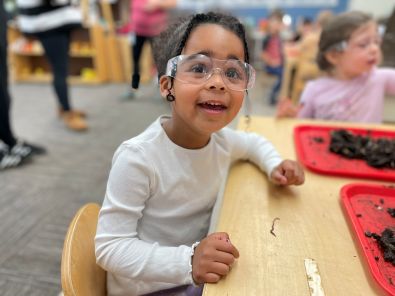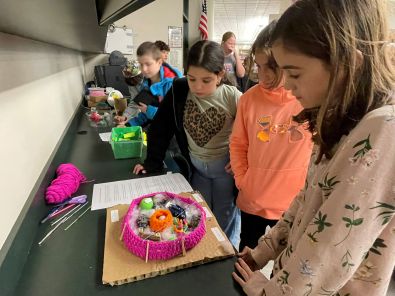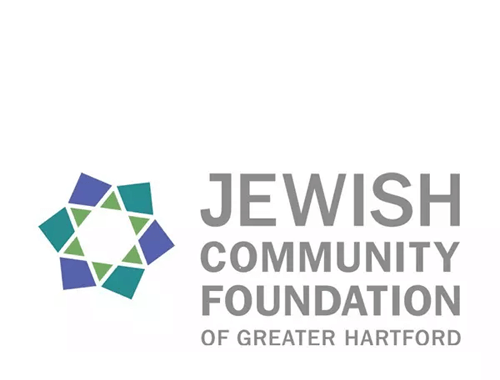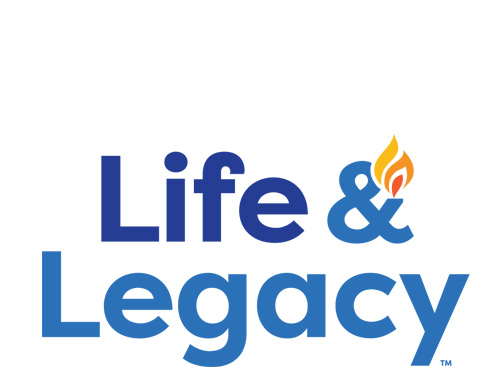Schechter Shavua: November 14, 2025
Digging Into Discovery: Worm Habitats Inspire Young Scientists
 One of the fantastic things about Schechter’s Early Childhood program is that teachers develop units based on their students’ passions and curiosity; they don’t merely rely upon the same curriculum year after year. When the Shorashim students (EC 3-4) showed a fascination with digging in the dirt in their classrooms’ outdoor play spaces, the teachers sprang into action!
One of the fantastic things about Schechter’s Early Childhood program is that teachers develop units based on their students’ passions and curiosity; they don’t merely rely upon the same curriculum year after year. When the Shorashim students (EC 3-4) showed a fascination with digging in the dirt in their classrooms’ outdoor play spaces, the teachers sprang into action!
Shorashim students learned about worm habitats and made one! They read Diary of a Worm, talked about a habitat and were introduced about the life cycle of a worm and the band on them which shows they are a full adult.
To create their worm habitat, Shorashim Bet layered stones, crushed leaves, coffee grounds, and dirt to create an inviting home for their worms. A representative from the 4H farm came to Schechter, along with her massive collection of worms, and taught our students about worms and how integral they are to our environment. Worms love to eat compost, including peanut shells, cardboard, eggshells, and paper!
Click HERE to see more photos!
Planting Curiosity in Kindergarten
 Our Ilanot (Kindergarten)students recently took their learning beyond the classroom walls with a hands-on adventure at the Indian Rock Nature Preserve! Building on their science studies about plants and animals, the children explored how seeds travel, how plants grow, and how all living things are connected in nature.
Our Ilanot (Kindergarten)students recently took their learning beyond the classroom walls with a hands-on adventure at the Indian Rock Nature Preserve! Building on their science studies about plants and animals, the children explored how seeds travel, how plants grow, and how all living things are connected in nature.
After discovering the many ways seeds are spread—from wind and water to animals—the students became “seed distributors” themselves! Each child created their own imaginative “critter” designed to carry seeds just like creatures do in the wild.
Next, they set off on a nature walk, carefully observing and collecting different kinds of seeds and identifying a variety of plant species along the trail. The day wrapped up with a joyful hayride, where students spotted real-life examples of what they had been studying—bringing their classroom lessons to life in the most exciting way.
It was a day full of curiosity, creativity, and connection to the natural world—an experience our young scientists won’t soon forget!
Making Connections: Exploring “Human Machines” in Alim
 Learning is all about making connections—and our Alim students (grades 3–4) are doing just that! To deepen their understanding of robotics, they launched a new science unit titled “Human Machines.” This unit builds on their previous exploration of robots by examining how robotic functions mirror the movements of the human hand.
Learning is all about making connections—and our Alim students (grades 3–4) are doing just that! To deepen their understanding of robotics, they launched a new science unit titled “Human Machines.” This unit builds on their previous exploration of robots by examining how robotic functions mirror the movements of the human hand.
Students began by learning key anatomy terms—such as tendon, bone, and muscle—to understand the structures beneath our skin that make movement possible. They then constructed a model of a human finger, discovering how pulling on a string (representing tendons) causes the finger to bend at the joints.
To cap off the unit, the fourth graders took their learning a step further—designing and building a complete model hand that demonstrated how science, engineering, and creativity come together in motion.
Click to see a video on Facebook
Click to see a video on Instagram
What Can Students Learn About Biology from Yarn, Balloons, and Beads?
A whole lot, actually!
 Middle School science students dove hands-on into biology this month, transforming the Makerspace into a creative laboratory as they explored the structure of plant and animal cells. Working in collaborative groups, students built 3D cell models, using imagination and ingenuity to represent organelles such as the endoplasmic reticulum, mitochondrion, chloroplast, and nucleolus.
Middle School science students dove hands-on into biology this month, transforming the Makerspace into a creative laboratory as they explored the structure of plant and animal cells. Working in collaborative groups, students built 3D cell models, using imagination and ingenuity to represent organelles such as the endoplasmic reticulum, mitochondrion, chloroplast, and nucleolus.
Their creativity knew no bounds. A cardboard box became a plant cell wall. One group chose a bean-shaped object to represent the mitochondrion, while another cleverly used a battery—highlighting its role as the “powerhouse” of the cell. Students even used 3D pens to craft tiny ribosomes on the rough endoplasmic reticulum. Ari taught himself how to use a sewing machine, and Elsa and Adina crocheted parts of their cell models! It was inspiring to see their artistic flair bring scientific concepts to life.
This week, middle schoolers continued their study of cellular biology with a hands-on DNA extraction experiment—using strawberries! Although DNA is microscopic, every organism contains a remarkable amount of it. Students crushed strawberries, mixed them with salt and dish soap to break down the cell and nuclear membranes, and then added rubbing alcohol to precipitate the DNA. Watching the strands of genetic material clump together was a vivid reminder of the microscopic world that exists inside every living thing.
Click HERE for more photos!
Parashat Chayei Sarah -- The Impact of Legacy
Contributed by Sarah Montag, Director of Teaching and Learning
 As a young student in my Schechter school growing up, I was always excited when it was time to read the portion of Chayei Sarah as the Parashat Hashavua (weekly Torah portion). Each year I would get excited to see my own name in the title, and then a little bummed as I remembered that the first thing that happens in the portion is that Sarah dies! Despite that bummer of a moment, I have been able to form connections with the portion in other ways.
As a young student in my Schechter school growing up, I was always excited when it was time to read the portion of Chayei Sarah as the Parashat Hashavua (weekly Torah portion). Each year I would get excited to see my own name in the title, and then a little bummed as I remembered that the first thing that happens in the portion is that Sarah dies! Despite that bummer of a moment, I have been able to form connections with the portion in other ways.
In Parashat Chayei Sarah, we read about a pivotal moment in Jewish history: Abraham purchasing the Cave of Machpelah as a burial place for Sarah. On the surface, this story seems simple — a man buying a piece of land to honor his wife. But the Torah devotes an entire section to describing this transaction in great detail, emphasizing that Abraham paid for the land publicly and fully, ensuring that it would belong to his family forever. This was more than just a real estate deal. It was an act of legacy-building — the first permanent foothold of the Jewish people in the Land of Israel, a tangible symbol of continuity, faith, and future.
Later in the portion, Abraham ensures that his son Isaac will continue that legacy by marrying Rebecca, a woman who shares his values and commitment to kindness and faith. Through both these acts — securing land and securing a future generation — Abraham models what it means to build something that will endure beyond oneself. He teaches us that a true legacy is not only about what we own, but about the values and vision we pass on to those who come after us.
At Solomon Schechter, we too are part of a story about building something meant to last. Our founders — the dreamers who created this school — believed deeply in the power of Jewish education to shape lives and sustain our people. Just like Abraham purchasing land for future generations, they worked tirelessly to establish a home for learning, community, and connection. They secured a building, created a curriculum, and wove together the threads of education, religion, and love of Israel to create a strong foundation for all who would follow.
This year’s Hava Dunn z”l Legacy Project invites our students to connect personally with that story. By hearing directly from the school’s founders and early members — their “why” — and exploring the world in which Solomon Schechter Day School of Greater Hartford was born, students will gain insight into what it takes to create something meaningful and lasting. Beginning with a text study on the role of peoplehood and place, the 5th and 6th graders will begin to understand what it takes to start a new community. From there, they will explore the Jewish archives in West Hartford and learn interview skills to facilitate conversations with our school’s original founders and students. Through the lenses of education, pop culture, religion, and Israel, they’ll discover how a vision from decades ago continues to shape their daily lives today. These interviews will culminate with the students learning how to, and then producing their own podcasts or Instagram reels about their interviewee and the impact that interviewee had on Schechter.
We look forward to debuting the final product of this exciting new Hava Dunn z”l Legacy Project in the spring through different media forms. Just as Abraham’s actions in Chayei Sarah ensured that his faith and family would endure, so too do the efforts of our founders and current community ensure that the spirit of Schechter — its love of learning, Jewish identity, and connection to Israel — continues for generations to come. May we, like Abraham, continue to build wisely, dream boldly, and contribute to a legacy that will inspire those who follow in our footsteps.
Solomon Schechter Day School
of Greater Hartford
26 Buena Vista Road
West Hartford, CT 06107
© Solomon Schechter Day School of Greater Hartford | Site design Knowles Kreative




